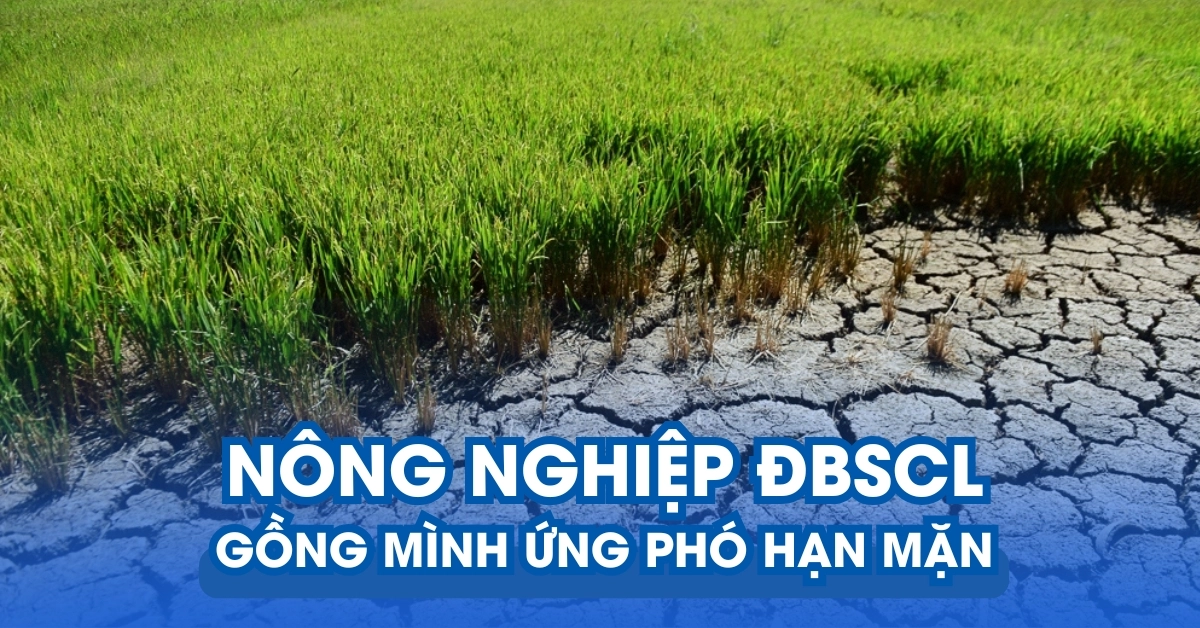Mekong Delta Agriculture Struggles to Cope with Saltwater Intrusion
25 Apr 2025

The Mekong Delta's agriculture is striving to cope with saltwater intrusion in early 2025 through water storage, crop adaptation, and a shift toward green farming.
Drought and Salinity: Challenges Intensify in Early 2025
Entering 2025, the Mekong Delta is once again facing severe drought and saltwater intrusion. These harsh conditions are affecting daily life and threatening the region’s most vital economic sector—agriculture.
Alarming Salinity Levels Across the Delta
According to the Southern Institute for Water Resources Research, water levels from the Mekong River’s upstream are significantly below average. As a result, saltwater has encroached earlier and deeper into inland areas, particularly between late February and mid-March, hampering crop production.
Dry season river flow now reaches only 60–75% of its historical average, reducing the capacity to dilute salinity and store fresh water.
Local Governments Take Action: Grassroots Solutions
In response, provincial authorities have activated immediate mitigation measures:
Bến Tre: Salinity Hotspot
As one of the hardest-hit provinces, Bến Tre had prepared freshwater reserves since late 2024. Mobile water tanks, pumping stations, and anti-salinity sluice gates are being fully utilized to supply remote communities. Farmers are advised to adjust crop calendars and shift to drought-resistant varieties.
Many residents in the Mekong Delta have proactively stored freshwater to cope with the ongoing saltwater intrusion.Source: VnEconomy
Vĩnh Long: Flexible Agricultural Transition
The province has successfully piloted salt-tolerant crops such as mango, coconut, and dragon fruit. Key irrigation systems have been upgraded to ensure water access for farming areas like Tam Bình and Trà Ôn.
Sóc Trăng: Dual Solution to Drought and Salinity
Farmers are guided to use water-saving techniques and adopt integrated farming models like rice-shrimp farming to cope with rising salinity levels.
Key Statistics
- Over 80,000 hectares of winter-spring rice were planted early in provinces like Long An, Cần Thơ, Tiền Giang, and Đồng Tháp.
- Nearly 2,500 pumping stations and salinity barriers are operating across the Delta.
- Tens of thousands of households have received access to clean water via mobile distribution systems.
Persistent Challenges Remain
Despite efforts, long-term salinity remains a pressing issue. Infrastructure investment, although significant, is still inconsistent in remote areas. The region’s heavy reliance on upstream water—which is increasingly unpredictable due to dam constructions—further complicates the situation.
There’s also a shortage of technical personnel and investment capital, slowing the expansion of adaptive farming models.
The Cái Lớn – Cái Bé project is the Mekong Delta’s largest irrigation system, built to manage saltwater intrusion and regulate freshwater. Source: Báo Lao Động
Long-Term Vision: Green Agriculture for Resilience
Provinces are moving beyond reactive measures and embracing climate-smart, sustainable agriculture through:
- Organic farming and reduced chemical usage
- Smart irrigation technologies
- Restructuring of crop and livestock systems based on ecological zones
Bến Tre, Vĩnh Long, and Cà Mau are pioneers, providing both technical support and business linkages to stabilize income and boost confidence among farmers.
A Collective Effort Needed
To respond more effectively to future salinity threats, a collaborative approach is required:
- Government: Increase investment in irrigation and develop regional water management plans.
- Businesses: Participate in the green agricultural value chain.
- Farmers: Embrace new knowledge, technology, and sustainable farming practices.
Conclusion
The year 2025 continues to test the resilience of agriculture in the Mekong Delta. However, the proactive responses at both provincial and local levels showcase the region's determination. With the right direction and coordinated support, the Delta can overcome current challenges and build a smart, climate-resilient agricultural future.
Views
679
